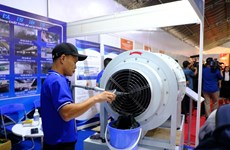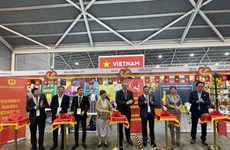FTAs help ensure sustainable economic growth: official
Free trade agreements (FTAs) not only open up opportunities for Vietnam
to stimulate the national economy but also reduce and gradually remove
dependence on the Chinese market, towards ensuring a sustainable
economic development.
Free trade agreements (FTAs) not only open up opportunities for Vietnam
to stimulate the national economy but also reduce and gradually remove
dependence on the Chinese market, towards ensuring a sustainable
economic development.
Radio The Voice of Vietnam (VOV) quoted Chamber of Commerce and Industry of Vietnam (VCCI) Chairman Vu Tien Loc as saying at a recent discussion on socio-economic development in Hanoi at the current session of the 13th National Assembly (NA).
Many NA deputies stated that the illegal placement by China of its oil rig in Vietnam’s exclusive economic zone is a serious violation of Vietnam’s sovereignty and to some extent it would affect trade relations between Vietnam and China.
Loc said that Vietnam is standing on the threshold of FTAs with the world’s largest partners. Trans-Pacific Partnership Agreement (TPP) negotiations between Vietnam and its partners are entering final periods while the Vietnam-EU Free Trade Agreement (VEFTA) negotiations are expected to conclude later this year.
"Preparation for the country to seize opportunities and overcome challenges from FTAs at this time is more urgent than ever," he said.
According to Loc, Vietnam is facing new demands for maintaining stable trade relations with China and intensifying measures to ease its reliance on the Chinese market. Taking advantage of opportunities from FTAs is an effective way to achieve this goal.
More than half of Vietnam’s garment and textile materials are imported from the Chinese market and up to 90 percent of Engineering, Procurement and Construction (EPC) contracts from thermal power projects are carried out by Chinese contractors. The main reason is the abundant and relatively cheap supply of credits, raw materials and goods from China.
With its commitment to remove and at least reduce tariffs and technical barriers to the lowest levels in FTAs with the world’s leading partners in the future, Vietnam will have a good chance to import machinery, equipment, input materials, consumer goods from the US, the EU, Japan, the Republic of Korea (RoK), Australia, New Zealand and Russia.
"Vietnam can take advantage of these opportunities to attract investment in developing support industry, so as to reduce imported inputs in key business areas of the Vietnamese economy," Loc noted.
In terms of economic output, according to official figures cited by Loc at the NA session, China accounts for about 10 percent of Vietnamese exports. Despite not being the biggest export market, China is Vietnam’s biggest fruit and vegetable export market and consumes a large volume of rice and other agricultural products from Vietnam.
So, to invest enough in the output chain for goods, especially agricultural products in the demanding global markets, Loc stressed the need to find a way out for the national economy to avoid the current dependence.
“But the fact is that we are trading in a global trade and economy, where every business, every economy is bound and closely linked to each other. This is true for both Vietnam and China,” he said.
While many people are concerned about China’s reaction against Vietnam in the context of escalating tensions in the East Sea by closing its border, stopping import and export activities with Vietnam, many others said that for the time being, it is not easy for China to stop trade activities at least on a large scale.
Trade activities with Vietnam are the main source of income for some of China’s poor provinces. Vietnam is also the largest market in Southeast Asia for Chinese contractors. Chinese investors are enjoying big or small benefits from direct or indirect investment projects in Vietnam. All this makes people think twice before considering what measures should be taken.-VNA
Radio The Voice of Vietnam (VOV) quoted Chamber of Commerce and Industry of Vietnam (VCCI) Chairman Vu Tien Loc as saying at a recent discussion on socio-economic development in Hanoi at the current session of the 13th National Assembly (NA).
Many NA deputies stated that the illegal placement by China of its oil rig in Vietnam’s exclusive economic zone is a serious violation of Vietnam’s sovereignty and to some extent it would affect trade relations between Vietnam and China.
Loc said that Vietnam is standing on the threshold of FTAs with the world’s largest partners. Trans-Pacific Partnership Agreement (TPP) negotiations between Vietnam and its partners are entering final periods while the Vietnam-EU Free Trade Agreement (VEFTA) negotiations are expected to conclude later this year.
"Preparation for the country to seize opportunities and overcome challenges from FTAs at this time is more urgent than ever," he said.
According to Loc, Vietnam is facing new demands for maintaining stable trade relations with China and intensifying measures to ease its reliance on the Chinese market. Taking advantage of opportunities from FTAs is an effective way to achieve this goal.
More than half of Vietnam’s garment and textile materials are imported from the Chinese market and up to 90 percent of Engineering, Procurement and Construction (EPC) contracts from thermal power projects are carried out by Chinese contractors. The main reason is the abundant and relatively cheap supply of credits, raw materials and goods from China.
With its commitment to remove and at least reduce tariffs and technical barriers to the lowest levels in FTAs with the world’s leading partners in the future, Vietnam will have a good chance to import machinery, equipment, input materials, consumer goods from the US, the EU, Japan, the Republic of Korea (RoK), Australia, New Zealand and Russia.
"Vietnam can take advantage of these opportunities to attract investment in developing support industry, so as to reduce imported inputs in key business areas of the Vietnamese economy," Loc noted.
In terms of economic output, according to official figures cited by Loc at the NA session, China accounts for about 10 percent of Vietnamese exports. Despite not being the biggest export market, China is Vietnam’s biggest fruit and vegetable export market and consumes a large volume of rice and other agricultural products from Vietnam.
So, to invest enough in the output chain for goods, especially agricultural products in the demanding global markets, Loc stressed the need to find a way out for the national economy to avoid the current dependence.
“But the fact is that we are trading in a global trade and economy, where every business, every economy is bound and closely linked to each other. This is true for both Vietnam and China,” he said.
While many people are concerned about China’s reaction against Vietnam in the context of escalating tensions in the East Sea by closing its border, stopping import and export activities with Vietnam, many others said that for the time being, it is not easy for China to stop trade activities at least on a large scale.
Trade activities with Vietnam are the main source of income for some of China’s poor provinces. Vietnam is also the largest market in Southeast Asia for Chinese contractors. Chinese investors are enjoying big or small benefits from direct or indirect investment projects in Vietnam. All this makes people think twice before considering what measures should be taken.-VNA













